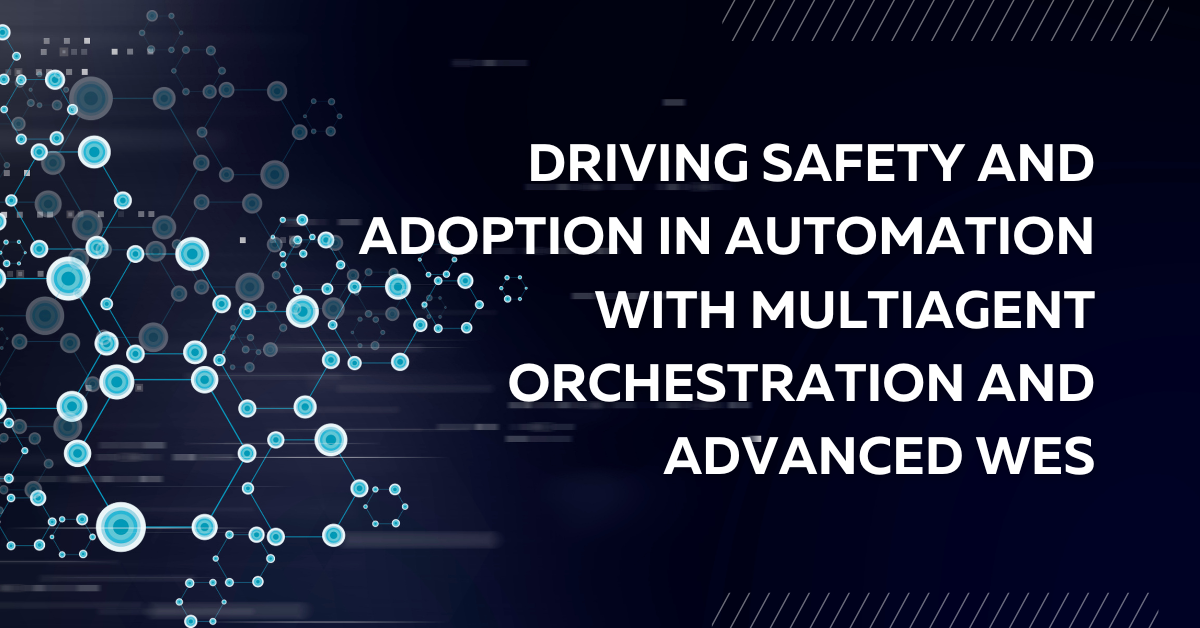


As the automation industry expands at a projected 15.9% compound annual growth rate (CAGR), the focus on safety and efficiency has become paramount. Multiagent orchestration (MAO) through an advanced Warehouse Execution System (WES) plays a vital role in managing these aspects. This sophisticated system coordinates the operations of numerous robotic agents, humans and other material handling equipment (MHE), enabling smoother workflows, optimized task execution and enhanced safety for human workers.
In this blog post, we’ll explore how MAO through a modern WES can help drive safety and adoption in complex automation environments.
MAO refers to the capability of a system to manage and synchronize the activities of multiple autonomous agents — robots, automated systems or humans — within a shared space. In a typical warehouse setting, there could be several different types of robots (from several different vendors) working alongside humans to complete various tasks such as picking, packing and transportation. Without proper coordination, they could collide, create bottlenecks or perform redundant tasks, which would negatively impact efficiency and safety.
An advanced WES plays a pivotal role in mitigating these risks by acting as a “central brain”. It ensures that all agents – both human and robotic – operate in harmony. This orchestration optimizes the allocation of tasks, enables real-time communication between systems, and prioritizes safety protocols, all while increasing throughput and reducing downtime.
RELATED RESOURCE: Multiagent Orchestration, Explained
The advanced WES is the heart of modern warehouse automation. Its responsibilities go beyond just task assignment to include:
By handling these aspects, the WES acts as the conductor of a complex, automated symphony where each robotic or human agent is a musician playing a part. At the same time, all agents are working together to produce a seamless, efficient outcome.
Safety is one of the most crucial concerns in a warehouse or distribution center, especially in environments where robots and humans work together. The presence of multiple autonomous robots can introduce risks of collision, accidents and operational hazards. However, multiagent orchestration through a WES mitigates these risks via advanced algorithms, real-time monitoring and predictive analytics.
Here are a few of the ways an advanced WES can enhance safety:
By continuously tracking the movement and tasks of every robot in the system, the WES can predict potential collisions and reroute robots to prevent accidents. The system can identify high-traffic zones and adjust robot paths to ensure smooth operations.
The WES divides the workspace into distinct zones for specific activities. This spatial separation minimizes the risk of accidents and creates an environment where robots and humans can work alongside each other more safely.
If an issue arises, such as a robot malfunctioning or human-robot interaction becoming unsafe, the WES can immediately halt robot operations in the affected zone and alert the appropriate personnel. This instantaneous response helps prevent accidents and minimizes downtime.
WES systems can monitor the operational health of robots, predicting when maintenance is required before any failures occur. This minimizes unplanned downtime, prevents accidents caused by malfunctioning robots and increases overall system reliability.
Through these measures, an advanced WES becomes the foundation for creating a safer working environment in today’s increasingly complex automation systems.
As automation technology advances, many industries are becoming more receptive to the integration of robots in their workflows. However, widespread adoption hinges on the perceived reliability, efficiency and safety of these systems. A robust WES that effectively orchestrates multiple agents directly influences these factors and promotes the adoption of automation systems through the following aspects.
The WES simplifies the complex interactions between various robots, enabling them to work together seamlessly. For example, a tote-to-person solution might involve collaboration between vertical tote mover (VTM) and horizontal tote mover (HTM) robots to enable maximum storage density and throughput.
This multiagent orchestration not only optimizes efficiency but also reduces the manual oversight needed from human supervisors. As a result, robotic automation becomes more user-friendly and appealing to businesses.
The flexibility of MAO allows businesses to scale their operations easily. As demand grows, whether during peak seasons or unexpectedly, additional robots can be integrated into the system without overhauling the entire operation. The WES ensures that new agents are effectively incorporated into the existing workflow.
Increased efficiency leads to lower operational costs. By optimizing the tasks performed by robots and reducing energy consumption, the WES contributes to a faster return on investment (ROI). In turn, more companies are motivated to adopt automation.
With better coordination and optimized task execution, MAO leads to higher throughput without compromising safety or accuracy. This allows businesses to meet higher production demands more easily, further driving the adoption of automation systems.
By efficiently managing multiple autonomous agents, ensuring safety through advanced collision avoidance and traffic management, and increasing overall system reliability, an advanced WES promotes both the safety and adoption of automation technologies.
The future of warehouse automation depends on the continued evolution of systems like the WES. As they grow more sophisticated, these systems will open new possibilities for greater automation while ensuring that workplaces remain safe and efficient. To stay up to date on the latest warehouse automation technologies and trends, follow us on LinkedIn.